#shophouses
Explore tagged Tumblr posts
Text

My piece for Streets of Zine around the world Painted George town in Penang, Malaysia ; ) Streets of zine's twitter: https://x.com/StreetsOfZine They also have IG with the same handle Feel free to check out the other artists' work!
#illust#painting#illustration#original#art#streets#shophouses#streetsofzine#scenery#backgroundart#artists on tumblr#malaysia#penang#georgetown
14 notes
·
View notes
Text

Commercial street with high rise office buildings beyond, Singapore - Jalan komersial dengan bangunan pejabat tinggi di seberang, Singapura - 新加坡商业街,周边��高层办公楼 - (சிங்கப்பூருக்கு அப்பால் உயரமான அலுவலக கட்டிடங்களைக் கொண்ட வணிக வ���தி), 1979.
9 notes
·
View notes
Text

Barndominium / Shop House Plans | Nelson Design Group
A collection inspired by the love of the simpler things in life, Nelson Design Group brings you our Barndominium and Shop House Plan Collection. With simply beautiful exteriors, metal roofing, and a more simplified layout, our Barndominiums and Shop House Floor Plans are perfect for your next home build.
Have you been looking through our Barndominium and shop House floor plans? : https://www.nelsondesigngroup.com/houseplans/PhotoView/PlanCollection/barndominium_shop_house_plans?fbclid=IwAR20bmSKDS2SWbHTlqTijrv9Yfp8mJQdv_xI-bLIb1wWTJsHjoFru4F63mg
Need a house plan?.... visit: https://www.nelsondesigngroup.com/
#houseplans#nelsondesigngroup#barn#barnhome#barnhomes#barnhomedecor#barnhomestyle#barndo#barndominium#barndominiums#barndominiumlife#barndominiumliving#Shophouse#shophouse#shophouses#shophousedesign#homeplans#housedesign#floorplan#architecturaldesign#homedesign#archilovers#houseplan#architecture#floorplanner
2 notes
·
View notes
Text

July 2024
0 notes
Text
what i would really really love to do (my dream build) is make like a straits eclectic & malaysian art deco style shophouse 'street' diorama i can picture it in my head and it would be so beautiful....
25 notes
·
View notes
Text
i think the aesthetics and vibes of the combination/fusion of eastern (asian) and western cultures is really cool and sexy and i'm not biased at all
#me when immigration or globalisation creates something New. wow. wow. oh man. wow.#yeah colonialism is bad but also. artistically seems very very interesting to explore. fuckin. expensive hotels with palm leaves and shit#black and white colonial houses. five foot ways and shophouses#the aesthetics of “exploration” and conquest#dude if i ever get good enough at writing and handling complex themes#i REALLY want to explore that space of exoticism and orientalism and colonialism of the east... the interaction of cultures..#its jsut so tasty
3 notes
·
View notes
Text

[drawn on 13/6/2024]
Trying out sketches of places Ann Siang Hill, Singapore
3 notes
·
View notes
Text
Kaffir Street Tour
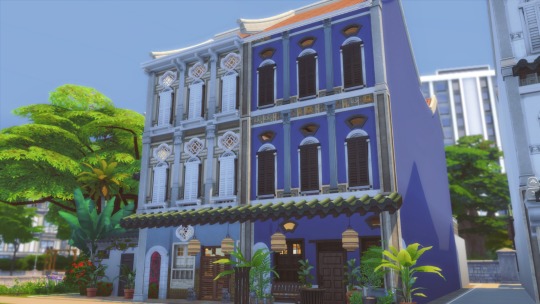
This stretch of Shophouses, located at Kaffir Street, are typical of the many homes of the rich merchant classes in colonial Singapore (1819-1941). Shophouses in a way, are a condensed expression of the sprawling Chinese courtyard estate known as the Siheyuan. Shophouses, however, are multi storey, built wall to wall, opening to the street, and often have ornate, colourful facades, showcasing the best of regional craftsmen who worked with plaster, porcelain and wood carving to create the iconic Shophouse fronts, often festooned with mythological friezes, auspicious symbols and art.
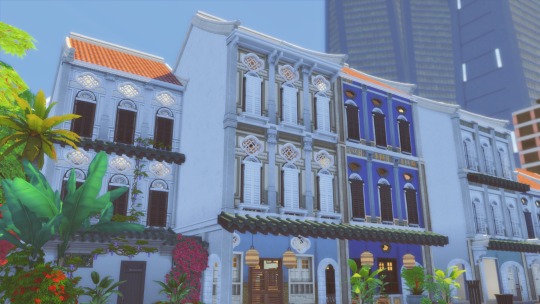
While called shophouses, many were in fact purely residential, and are more or less townhouses. The front, ground floor of the Shophouse features a sheltered corridor that links the shophouses together, known as the Five foot way. These walkways served as a way for pedestrians to stay out of the rain and sun, and in quieter residential areas, also doubled as a kind of verandah.

The entrance to the home leads to the main reception room, where guests and business associates are recieved and entertained. The standard layout for this room features a central round table with stools or chairs, and with traditional Chinese hardwood chairs flanking the walls on either side. This is typical of a Chinese style reception hall where guests sit side by side, with chairs divided by side tables.

The reception hall is decorated with the very best objects and art to showcase the household's refinement and values, or portraits of the family's many predecessors, to highlight the family's lineage. The more domestic hind quarters of the home are separated from the more businessy reception hall by a large, ornate wooden screen, in front of which is usually the family's altar.
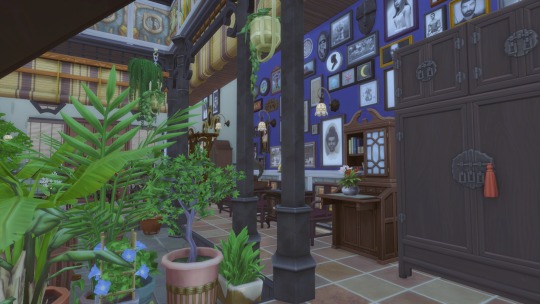
Beyond the divider screen lies the heart of the home, the courtyard. Due to a tax imposed on the width of a house, shophouses became fairly narrow, but were very deep. The courtyard, or airwell, was an important feature to allow light and air into the deep recesses of the home, and served as a form of air conditioning, helping to cool the interiors by circulating air.
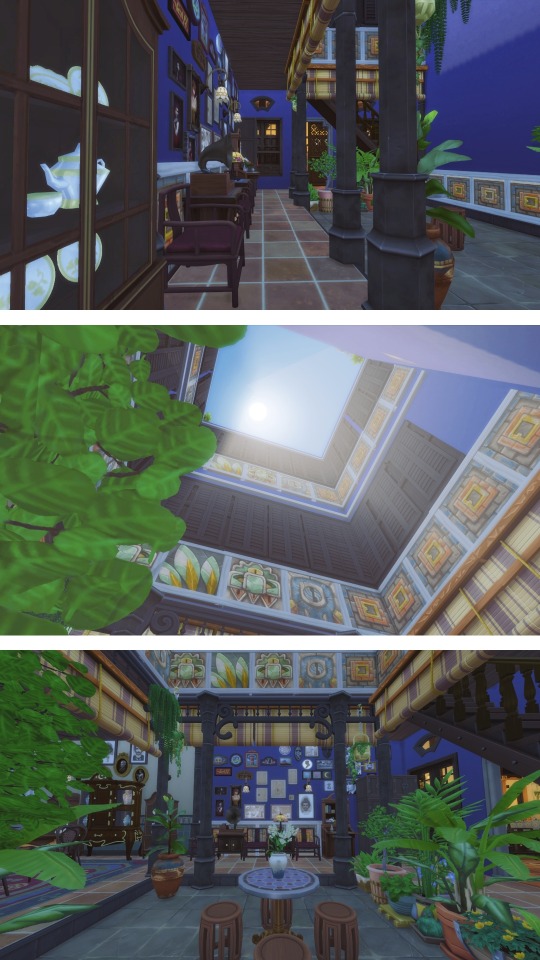
In many homes, it became a living and dining area, where more intimate guests were invited to join in family meals. The courtyard is also where the main, or only staircase is located. Because of water's symbolism in Chinese culture for wealth and abundance, the courtyard is also an important symbolic feature, where rainwater pools, symbolising the accumulation of wealth for the home. The rainwater is also collected and used for washing. It was also important to have plants and nature in the courtyard, better still, symbolically significant plants.

While many inhabitants of the Shophouse were Chinese or Peranakan, and the home is laced with Chinese sensibilities, symbolism and aesthetics, the Shophouse at its peak, was essentially a Victorian/Edwardian era home. Many homes featured trendy electrical or gas light fittings, European furniture and the very latest technology of the time.
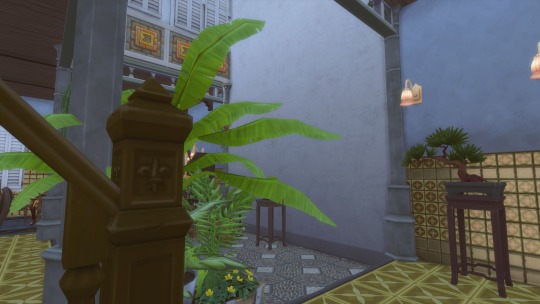
Upstairs lies the bedrooms and private spaces of the house. Typically there are several rooms that feature more traditional Chinese-style beds, that is, raised beds covered by a canopy structure. As usual, these bed chambers are covered in auspicious motifs and symbols, and are usually assigned to a newly married son and his wife, in the hopes that they may produce an heir, as many of these homes were multi-generational. In keeping with the times, however, many shophouses also had more contemporary bedrooms, done up in a more European style. Including such novelties as metal bed frames, lace, linen, European style desks and the like.
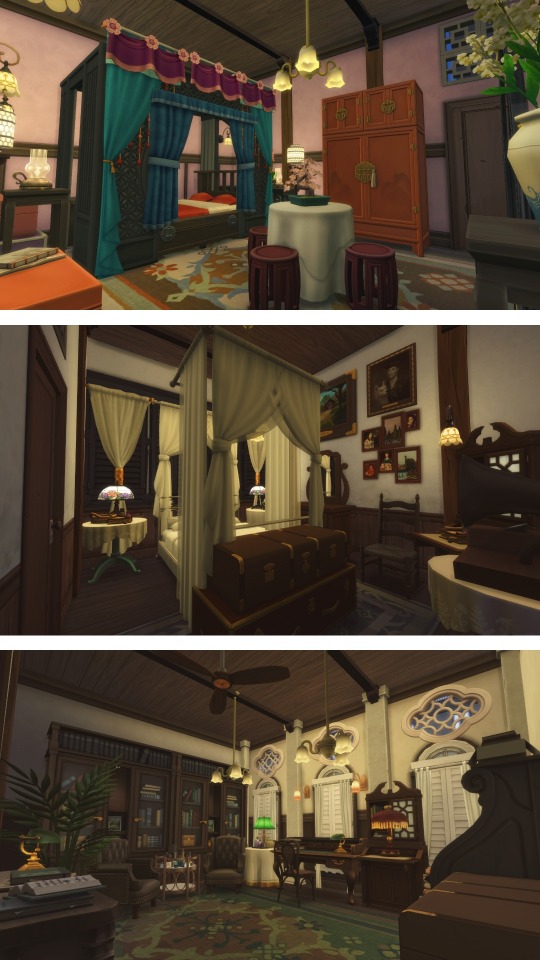
The back of the house usually features another courtyard, and a partially open air space, in which is usually built a kind of outhouse, as well as where the washing and cooking is done. Individual inhabitants of the home usually washed and performed ablutions in their rooms with tubs and chamberpots. Servants often just resided in this back portion of the house, as this is where most of their lives took place.

18 notes
·
View notes
Text
Exploring the Peranakan Culture in Singapore
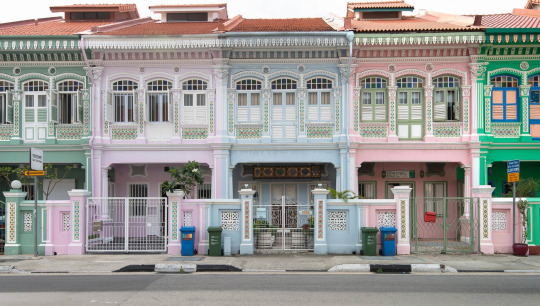
The vibrant tapestry of Singapore's cultural landscape is incomplete without the rich threads of Peranakan heritage. Just as the nocturnal Wildlife Park Singapore beckons nature enthusiasts, the term "Peranakan" refers to the descendants of Chinese immigrants who came to the Malay Archipelago, including Singapore, during the 15th to 17th centuries. This unique cultural fusion has given rise to a distinct Peranakan identity that encompasses aspects of Chinese, Malay, and Indonesian traditions. Amidst the hustle and bustle of the city, akin to the thrill of the reverse bungee in Singapore, the Peranakan culture stands as a captivating testament to the harmonious blend of diverse influences in this vibrant metropolis.
Historical Background
Early Migration: The Peranakan story begins with the migration of Chinese communities to the Malay Archipelago. These early settlers intermarried with local Malays, resulting in a harmonious blend of cultural practices.
Cultural Fusion: The Peranakan culture stands as a testament to the amalgamation of Chinese, Malay, and Indonesian influences. The fusion extends beyond mere culinary preferences, permeating every aspect of daily life.
Distinctive Peranakan Cuisine
Iconic Dishes: Peranakan cuisine, also known as Nyonya cuisine, is celebrated for its unique blend of flavors. Signature dishes like Laksa, Ayam Buah Keluak, and Kueh Dadar showcase the intricate marriage of Chinese and Malay culinary techniques.
Culinary Traditions: The preparation of Peranakan dishes involves time-honored traditions passed down through generations. The meticulous use of herbs, spices, and indigenous ingredients contributes to the unmistakable Peranakan flavor profile.
Peranakan Art and Craft
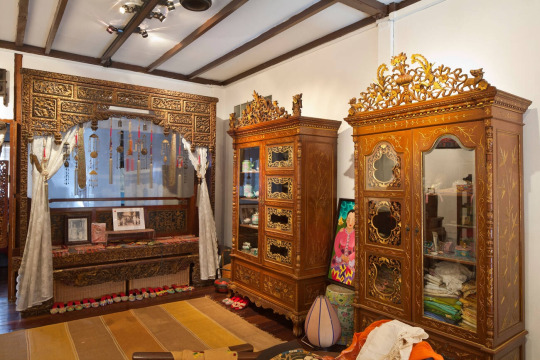
Intricate Designs: Peranakan art is characterized by intricate designs, often seen in textiles, ceramics, and architecture. These designs reflect the cultural diversity and are a visual representation of the Peranakan identity.
Symbolism in Art: Each piece of Peranakan art tells a story. The intricate patterns on porcelain, known as "straits Chinese porcelain," are laden with symbolic meanings, representing prosperity, good luck, and familial ties.
Traditional Peranakan Clothing
Sarong Kebaya: The traditional attire of Peranakan women, the Sarong Kebaya, is a graceful ensemble comprising a kebaya blouse paired with a batik sarong. This attire is a symbol of Peranakan femininity and grace.
Beaded Slippers: Completing the ensemble are beaded slippers known as "kasut manek." These meticulously crafted shoes are a hallmark of Peranakan fashion, showcasing intricate beadwork and vibrant colors.
Architecture and Heritage Homes
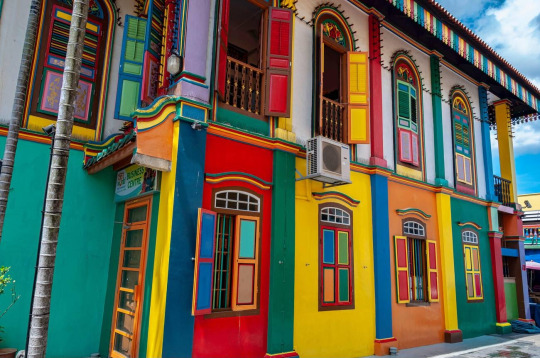
Shophouses and Their Significance: Peranakan influence is also evident in the architecture of shophouses. Elaborate facades, vibrant colors, and ceramic tiles contribute to the distinctiveness of Peranakan-style buildings.
Preserving Peranakan Heritage: Efforts to preserve Peranakan heritage include the restoration and conservation of heritage homes. These initiatives aim to maintain the authenticity of Peranakan architecture for future generations.
Language and Literature
Unique Language – Baba Malay: The Peranakan community developed its own language, known as "Baba Malay." This linguistic blend incorporates elements of Malay, Chinese, and Indonesian, further emphasizing the cultural amalgamation.
Folktales and Stories: The rich oral tradition of Peranakan culture is encapsulated in folktales and stories that have been passed down through generations. These narratives offer insights into the community's history, values, and customs.
Festivals and Celebrations
Peranakan Weddings: Peranakan weddings are elaborate affairs, blending Chinese and Malay wedding customs. Intricate ceremonies, vibrant costumes, and traditional rituals make these celebrations a unique and visually stunning experience.
Lunar New Year Celebrations: The Lunar New Year holds special significance for Peranakans. The festivities include elaborate family reunions, traditional feasts, and the iconic tossing of the yusheng for prosperity and good fortune.
Challenges in Preserving Peranakan Culture
Modernization Impact: The relentless march of modernization poses challenges to preserving Peranakan culture. Changing lifestyles, urban development, and globalization threaten to erode the distinctiveness of this unique heritage.
Efforts for Cultural Conservation: Despite challenges, various initiatives aim to safeguard Peranakan culture. Museums, cultural organizations, and community-driven projects work tirelessly to document, preserve, and celebrate the rich Peranakan legacy.
Peranakan Influence in Modern Singapore
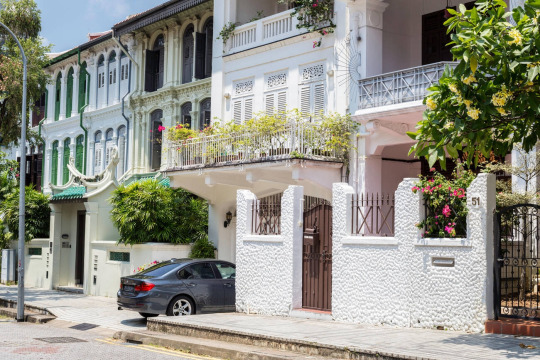
Contemporary Peranakan Culture: The Peranakan influence extends beyond traditional boundaries. Today, Peranakan culture is embraced in contemporary settings, influencing fashion, design, and culinary trends in modern Singapore.
Popular Peranakan Establishments: The popularity of Peranakan cuisine has led to the establishment of renowned Nyonya restaurants and Peranakan-inspired cafes. These establishments not only showcase the culinary heritage but also serve as hubs for cultural exchange.
Tourism and Peranakan Experience
Peranakan Museums: Museums dedicated to Peranakan culture offer visitors a deep dive into the history, art, and traditions of the community. The artifacts and exhibits serve as a testament to the resilience and vibrancy of Peranakan heritage.
Cultural Tours: Guided cultural tours provide an immersive experience, allowing visitors to explore Peranakan neighborhoods, sample authentic cuisine, and witness the living traditions that continue to thrive in the community.
Personal Narratives
Interviews with Peranakan Community Members: Personal narratives from members of the Peranakan community offer a unique perspective. Interviews highlight the challenges faced, the pride in preserving culture, and the ongoing efforts to pass down traditions to future generations.
Stories of Cultural Preservation: Heartwarming stories of individuals and communities actively engaged in preserving Peranakan culture showcase the resilience and determination to ensure that this rich heritage remains alive and thriving.
Conclusion

In the tapestry of Singapore's multicultural identity, the Peranakan culture weaves a vibrant and colourful thread. From its humble beginnings to the challenges of modernization, the Peranakan community stands resilient, proudly preserving its unique heritage. As we explore the intricate blend of traditions, art, cuisine, and personal narratives, it becomes evident that Peranakan culture is not just a relic of the past but a living, breathing entity shaping the cultural landscape of contemporary Singapore.
#Peranakan Culture#Singapore Heritage#Chinese-Malay Fusion#Nyonya Cuisine#Peranakan Art#Sarong Kebaya#Straits Chinese Porcelain#Shophouse Architecture#Baba Malay Language#Lunar New Year Celebrations#Cultural Conservation#Modern Peranakan Influence#Peranakan Museums#Cultural Tours#Personal Narratives#Nocturnal Wildlife Park Singapore#Reverse Bungee in Singapore#Singapore Tourism#Cultural Diversity#Unique Singapore Experiences#Peranakan Cultural Preservation
5 notes
·
View notes
Text







Watercolour, gouache paintings of urban landscapes, nightscapes, streets of Chinatown Singapore, Singapore Heritage shophouses, lantern festival vibes, Osaka castle, and night scenery. Done sometime between 2010 to 2014, mixed media between Chinese paints, watercolour, and cheap poster paints.
#watercolor#watercolour art#watercolourpainting#watercolour illustration#watercolour sketch#shophouse#chinatown#city life#women artists#realism#acrylic#painting
2 notes
·
View notes
Text
Shophouse là gì
Shophouse, hay còn gọi là nhà phố thương mại, là mô hình kết hợp giữa không gian sống và cửa hàng phục vụ cho hoạt động kinh doanh. Mô hình sản phẩm này rất phổ biến tại các nước phát triển và đang ngày càng được ưa chuộng trên thị trường bất động sản Việt Nam nhờ vào khả năng sinh lời ổn định.
0 notes
Link
3 carpark SHOPHOUSE DANARA NORTH LILOAN
0 notes
Text
Pre-Owned Dormitory near Angeles University Foundation
Ready-made Income! Pre-owned dormitory near Angeles University Foundation. 70m to Manila North Rd, 300m to AUF. 3 units w/ own kitchens. Perfect for investors! #JMListings
📍Claro M Recto, Angeles City Pampanga FEATURES TYPE: Dormitory/Apartment📐 Lot: 150 square meters | Floor: +/- 140 square meters✅ 70 meters walk to Manila North Rd (MacArthur Highway)✅ 300 meters walk to AUF Main Campus✅ 3 Units with own kitchen1ST Unit – 2 Beds, 2 Baths2ND Unit – 2 Beds, 1 Bath3RD Unit – Studio, 1 Bath 🏷️ 8,500,000✅ CASH only➕ Transfer title expensesPRICES, TERMS, AND…
#angeles pampanga#Asia#Capital Town Pampanga#commercial lots pampanga#commercial space sale pampanga#condo for sale pampanga#condo in pampanga#condo pampanga#condo san fernando pampanga#condominiums for sale pampanga#House and Lot Pampanga#jm listings#Megaworld Pampanga#Pampanga#Philippines#real estate agent pampanga#REAL ESTATE PAMPANGA#San Fernando#San Fernando Pampanga#shop house pampanga#shophouse#shophouse district#shophouse megaworld#shophouse pampanga#sindalan
0 notes
Video
youtube
THỰC TẾ SHOPHOUSE LUMIERE BOULEVARD | D1.TMDV.04
0 notes
Text
[Check-in] Công trình Thiết kế thi công biệt thự Vinhomes Ocean Park 2
Vào những ngày đầu tháng 9 năm 2024, Chúng tôi theo chân Nhà thầu thiết kế thi công nội thất Matrix Studio đã có mặt tại Phân khu Biệt thự San Hô – Vinhomes Ocean Park 2 để tiếp tục triển khai công việc thiết kế thi công nội thất Biệt thự Shophouse liền kề cho những khách hàng đã đăng ký nhận ưu đãi. Biệt thự Vinhomes Ocean Park 2 – sở hữu vị trí đắt giá phía đông Hà Nội, thiết kế kiến trúc sang…
#nhà thầu thi công nội thất biệt thự vinhomes ocean park2#nhà thầu thiết kế thi công nội thất matrix studio#thiết kế thi công biệt thự vinhomes ocean park2#thiết kế thi công shophouse vinhomes ocean park2
0 notes
Text
SIÊU HIẾM - CHỈ 3️⃣0️⃣ CĂN 𝐓𝐡𝐮̛𝐨̛𝐧𝐠 𝐏𝐡𝐨̂́ 𝐓𝐡𝐞 𝐒𝐮𝐧 - 𝐃𝐚̃𝐲 𝐒𝐡𝐨𝐩 𝐕𝐢𝐥𝐥𝐚 𝐆𝐢𝐨̛́𝐢 𝐇𝐚̣𝐧

✅ Duy nhất chỉ hơn 30 căn 𝐒𝐡𝐨𝐩 𝐕𝐢𝐥𝐥𝐚 đối diện trung tâm thương mại dịch vụ 5,2ha. 👉 Là dãy 𝐒𝐡𝐨𝐩 𝐕𝐢𝐥𝐥𝐚 độc bản được CĐT đặc biệt ưu ái về vị trí, thiết kế và định hướng phát triển. 👉 Là nơi đặt chân của Hàng loạt Đối Tác Lớn - Thương hiệu Top đầu Thế Giới. 🔰 Ngoài tiềm năng thương mại, với hơn 40% mảng xanh, tiện ích - một môi trường sống trong lành, trọn vẹn với 8 công viên và hơn 20 tiện ích Đẳng Cấp đã hoạt động -> Hiếm Khu đô thị nào có được. 🔥🔥 Đây là cơ hội hiếm có để sở hữu 𝐒𝐡𝐨𝐩 𝐕𝐢𝐥𝐥𝐚 đẳng cấp với giá chỉ bằng 𝟏/𝟑 khu vực thành phố mới Bình Dương.
SIÊU HIẾM - CHỈ 3️⃣0️⃣ CĂN 𝐓𝐡𝐮̛𝐨̛𝐧𝐠 𝐏𝐡𝐨̂́ 𝐓𝐡𝐞 𝐒𝐮𝐧 - 𝐃𝐚̃𝐲 𝐒𝐡𝐨𝐩 𝐕𝐢𝐥𝐥𝐚 𝐆𝐢𝐨̛́𝐢 𝐇𝐚̣𝐧
✅ Duy nhất chỉ hơn 30 căn 𝐒𝐡𝐨𝐩 𝐕𝐢𝐥𝐥𝐚 đối diện trung tâm thương mại dịch vụ 5,2ha. 👉 Là dãy 𝐒𝐡𝐨𝐩 𝐕𝐢𝐥𝐥𝐚 độc bản được CĐT đặc biệt ưu ái về vị trí, thiết kế và định hướng phát triển. 👉 Là nơi đặt chân của Hàng loạt Đối Tác Lớn - Thương hiệu Top đầu Thế Giới. 🔰 Ngoài tiềm năng thương mại, với hơn 40% mảng xanh, tiện ích - một môi trường sống trong lành, trọn vẹn với 8 công viên và hơn 20 tiện ích Đẳng Cấp đã hoạt động -> Hiếm Khu đô thị nào có được. 🔥🔥 Đây là cơ hội hiếm có để sở hữu 𝐒𝐡𝐨𝐩 𝐕𝐢𝐥𝐥𝐚 đẳng cấp với giá chỉ bằng 𝟏/𝟑 khu vực thành phố mới Bình Dương.
CHÍNH THỨC MỞ BÁN 𝗧HƯƠNG 𝗣HỐ 𝗧𝗛𝗘 𝗦𝗨𝗡 𝐏𝐡𝐮́ 𝐐𝐮𝐲́ 𝐇𝐨̣̂𝐢 𝐓𝐮̣ - 𝐑𝐮̛̣𝐜 𝐒𝐚́𝐧𝐠 𝐓𝐮̛𝐨̛𝐧𝐠 𝐋𝐚𝐢 ☎️Hotline tư vấn: 0972 582 667 🌐 Website: https://suncasacentral.biz/so-huu-shop-vila-thuong-pho-the-sun-vsip/
#nhaphovsip#shophouse#suncasacentral#suncasacentralbiz#vsip#Dautu#BietThu#Villa#NhaPho#TheSun#BatDongSan#bds#ToiYeuBinhDuong#NhaPhoVsip#Vsip1#Vsip2#Vsip3
0 notes